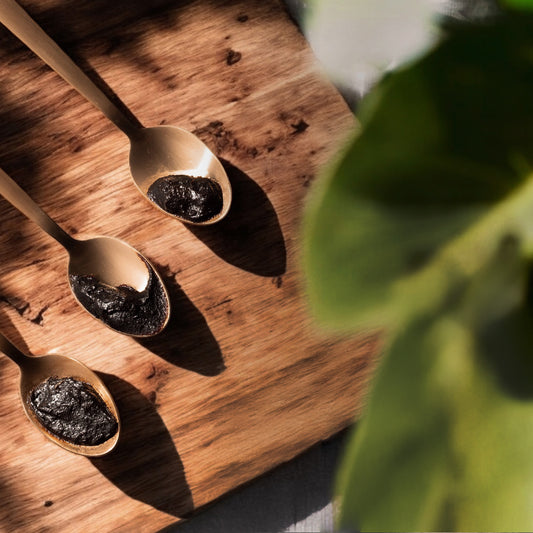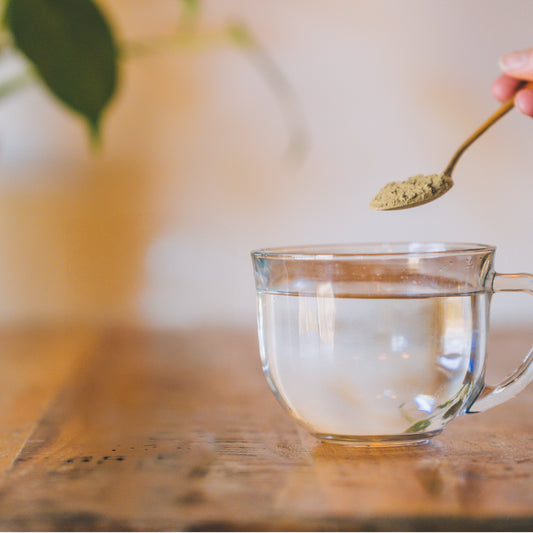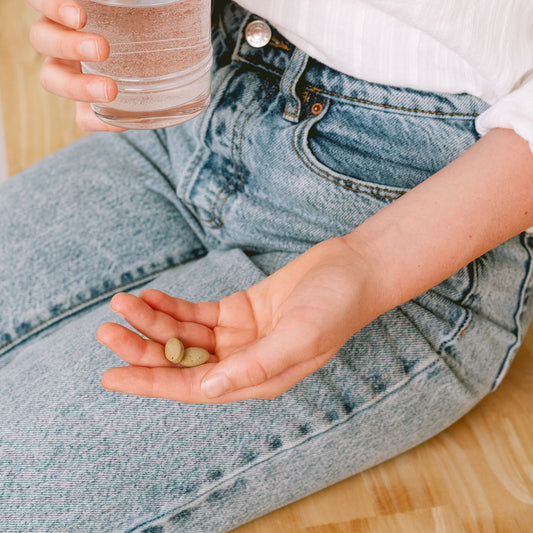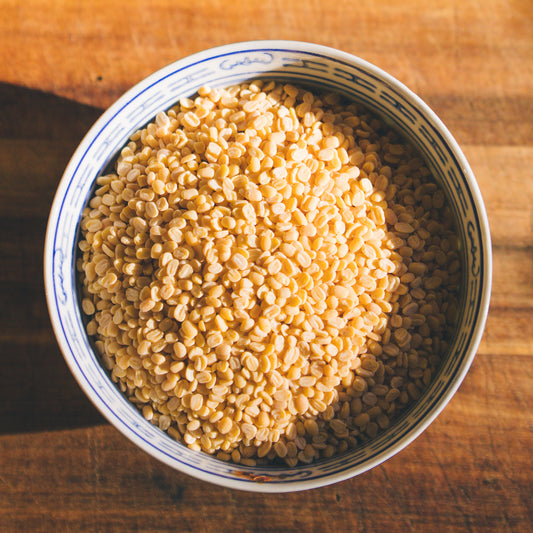Spring Guide
Stay Inspired and Revitalized This Spring with Ayurveda
Spring is upon us. Winter's accumulated snow and ice are beginning to melt. Gentle rains soak the land. The earth itself seems heavy with moisture—saturated with it—and the landscape is becoming a wellspring of life.
Spring is a season of birth, new beginnings, renewal, and growth—a time for the earth to make manifest the latent potential within all things. Seeds are germinating, flowers budding, insects buzzing, leaves unfurling.
And despite our growing separation from the natural world, we are deeply affected by this gentle stirring around us.
Our physiology senses a natural opportunity for a fresh, clean start; our bodies are primed to lighten things up, cleanse ourselves of any accumulated imbalances, and rejuvenate our deepest tissues.
As the natural world emerges from its long winter slumber, it is common to experience a renewed sense of joy and inspiration. But for many, the spring season is also associated with seasonal irritants, heaviness, and feelings of lethargy.
Thankfully, an appropriate seasonal routine can help us overcome spring's challenges while promoting optimal health so that we can truly celebrate the gifts this season has to offer.
In this article:
- Ayurveda's Perspective on Spring
- General Ayurvedic Tips for Spring Wellness
- Spring Tips for the Doshas
Ayurveda's Perspective on Spring
Spring is a season characterized by warmth (or at least less cold), moisture, and a palpable softness. It is a season revered for its gentle, nurturing presence. Spring embodies the heaviness of increased moisture, and it tends to feel slower than, say, summer or fall.
These are just a few of the characteristics that align spring with
But just as spring melts the lingering ice and snow, it liquefies accumulated kapha (ideally, so that it can be eliminated from the body). This process can either be a revitalizing event, or it can trigger a number of health challenges.
A seasonal routine is actually one of our best tools for minimizing spring's kapha-aggravating potential while supporting the elimination of any accumulated excess.
With a seasonal diet and lifestyle that invites a little extra lightness, sharpness, dryness, and heat into our lives, we can support our physiology in its natural process of springtime renewal and revitalization.
But remember that the entire point of an
Your local spring climate may, at first, fluctuate between wintery weather and warmer, wetter conditions—meaning that any given day could aggravate kapha,
Obviously, these patterns vary depending on where you live. Whatever the nuances of your local climate, you can respond to the qualities that are showing up by sprinkling in some appropriate recommendations for balancing vata in winter and balancing pitta in summer, when necessary.
Adapting your spring routine on a day-to-day basis like this is a beautiful way to honor the subtle variations within the season.
General Ayurvedic Tips for Spring Wellness
The following information is meant to introduce you to the principles at the heart of a springtime routine. It will also provide you with the foundational tools required to begin to piece together a routine of your own.
It may be helpful to familiarize yourself with the common manifestations of kapha imbalance so that you can address them quickly if they do arise. And, if you know your constitution, you can further refine your springtime routine to more specifically support your body type. After you've read the general information that follows, click on your Ayurvedic body type (links below) for further considerations specific to your constitution.
How to Create a Supportive Spring Diet
Many people notice a natural but distinct shift in their cravings as winter gives way to spring. The arrival of the warmer weather often marks a decline in our desire for the heavy, substantive foods so essential during the winter months.
In fact, many notice an increasingly insistent preference for lighter fare. Your appetite may decrease, and you may find yourself craving fruit, fresh vegetables, and salads galore.
This is your body's way of telling you that it's time for some spring cleaning. In fact, spring is a perfect time of year for a cleanse. Juice fasts with pomegranate or apple juice and monodiets are wonderfully supportive.
But even outside the confines of a structured dietary cleanse, you can support your body's natural desire to purify and renew by favoring the pungent, bitter, and astringent tastes and by eating warm, light foods that are relatively easy to digest.
These habits help balance mucus production, regulate moisture levels, and serve to open the
- You can start your day with a light breakfast of fresh fruit or tea.
- Lunches and dinners of light, cooked grains, steamed vegetables, and legumes are often perfect choices.
- Drink room temperature, warm, or hot beverages. You might even consider sipping on some warm water with a dab of honey throughout the day.
- Structure your diet around eating lots of fresh (but not necessarily raw) vegetables and a variety of legumes. These foods tend to be astringent and often somewhat bitter.
- Many also benefit from eating lots of bitter greens, cabbage family vegetables (cabbage, broccoli, cauliflower, etc.), and spicy foods like green chilies.
- Eaten in moderation, freshwater fish, tofu, and poached or hardboiled eggs are also appropriate during the spring season.
- You can enhance your meals with the pungent flavor of onions, garlic, ginger, black pepper, chili pepper, small amounts of cayenne pepper, and an unlimited variety of herbs and spices.
Ideal Spring Foods
The following is a list of ideal spring foods recommended by prominent leaders in the Ayurvedic community, including Usha and Vasant Lad, MASc, and John Douillard. 1,2
Fruits to Favor
|
|
Vegetables to Favor
|
|
Grains to Favor
|
|
Legumes to Favor
|
|
Seeds to Favor
|
Dairy to Favor (All in Moderation)
|
|
|
Animal Products to Favor (If You Eat Them)
|
|
Oils to Favor (In Very Small Quantities)
|
|
Sweeteners
|
|
|
Spices to Favor
All spices will generally be very supportive through the spring season.
Foods to Minimize in Spring
Foods that are best avoided during the spring include fast foods, sweets, soy products, nuts, excessive amounts of bread, and chilled or refrigerated foods—especially when eaten cold.
- Avoid heavy or watery veggies like avocado, cucumber, olives, sweet potato, squash, or zucchini.
- Gradually reduce your intake of heavy, oily, or fried foods.
- Try to curtail any tendency to overeat or snack between meals, and place less emphasis on the sweet, sour, and salty tastes.
- Heavy or sour fruits like oranges, bananas, pineapples, figs, dates, coconuts, and melons are also best reduced.
- Use very little oil or
- Do your best to minimize your intake of dairy products—especially in the morning—as they can be quite congesting. Rice milk and almond milk are suitable substitutes. If you do have cow's milk, boil it first, take it warm, and consider adding a pinch of turmeric or ginger to make it more digestible (and less congesting).
- Similarly, you may feel lighter and more invigorated if you eat less meat; beef, pork, seafood, and duck can be particularly aggravating at this time of year.
- If at all possible, eliminate iced or chilled drinks, ice cream, and popsicles.
How to Create a Supportive Spring Lifestyle
In general, you'll benefit most from the renewing nature of the spring if you develop some focused intentions for yourself. That said, it's equally important to embrace the light-heartedness that springtime tends to inspire.
Spring is a natural time to socialize and to initiate (or rekindle) meaningful relationships—to enjoy our friends and loved ones. It is also a great time to play.
As winter recedes, you can gradually begin to rise earlier. For most people, waking by or before 6 a.m. during the spring months is ideal.
Daily Routine for Spring
If you can, create a stimulating and inspiring morning routine for yourself, even if it's short.
- Brush your teeth, scrape your tongue, apply a few drops of Nasya Oil to your nasal passages, and drink some warm water first thing in the morning.
- You can also massage your skin with warm, organic sesame oil and then rinse off in a hot shower.
- If you don't have time for an oil massage every day, consider an invigorating dry rub before you bathe, or take a break during your shower to massage your skin with a dry herbal powder like amalaki or chickpea flour.
- Either way, start at your extremities and work your way toward the torso, rubbing your skin vigorously to stimulate heat, improved lymphatic circulation, fluid balance, and healthy, supple skin.
- Making time for exercise or
- Consider drying out excess moisture and fostering a sense of lightness with a nice relaxing sit in a sauna.
- Also, it's usually best to drink just enough fluid to stay hydrated.
- And while the nervous system will still benefit from some sense of routine throughout the day, spring is a good time to intentionally escape the status quo. Try something new, embrace a sense of playfulness and adventure, and give your wild side some outlets for expression.
- Dress in bright, warming colors like reds, yellows, and oranges in the early spring, while the weather remains cool and wet. As the weather heats up, gradually shift toward cooling blues, greens, purples, and whites.
- Finally, retire for bed sometime around 11 p.m. or even midnight. And while you won't want to overindulge on sleep during the spring, you might tolerate a slight increase in sexual activity.
Spring Exercise
Exercise can be incredibly supportive in countering the heavy, wet spring season. Physical activity improves circulation, increases heat, and results in a feeling of lightness—all of which help balance kapha.
Spring is also a good time of year to physically push yourself with longer, more intense workouts. But please continue to be mindful of the needs of your particular constitution.
Consider biking, jogging, hiking, or swimming and try to exercise in the morning, between 6 a.m. and 10 a.m. If your schedule won't accommodate a morning workout, evenings are an excellent time to exercise as well (again, ideally between 6 p.m. and 10 p.m.).
Please check with your doctor before starting a new exercise program.
Spring Yoga and Pranayama
Because kapha is a predominant force in winter and spring, there are many similarities between appropriate winter and spring yoga practices, with a few important distinctions. As in winter, many people will enjoy an expansive and stimulating spring yoga practice that is faster-paced, heating, and guided by precision and muscular effort.
In the spring, the emphasis on cleansing the lungs and warming the kidneys increases. Keep the chest open and the heart space expanded and when you feel as though you've been in a pose long enough to feel challenged, take one more deep, steady breath before releasing the posture.
Forward bends, chest openers, and backward bends can be very supportive at this time, as can
- Sun Salutation (Surya Namaskar)
- Warrior I (Virabhadrasana I)
- Warrior II (Virabhadrasana II)
- Reverse Warrior (Viparita Virabhadrasana)
Poses that stretch, compress, stimulate, and cleanse the solar plexus can also be supportive, like:
- Cobra (Bhujangasana)
- Bow (Dhanurasana)
- Side Plank (Vasisthasana)
- Spinal Rolls
- Leg Lifts
- Supine twists like Revolved Abdomen Variation (Jathara Parivartanasana Variation)
Spring is also an excellent time to reap the benefits of
Close your yoga practice with a shorter Savasana (Corpse Pose) and consider placing a bolster under your chest for increased benefit (Savasana with Support).
Ayurvedic Herbs for the Spring Season
Chyavanprash or Pippali. This spring, try taking a teaspoon or two of Chyavanprash every morning to boost your energy and support your immune system.
Or, to clear and rejuvenate the lungs, take ⅛–¼ teaspoon of pippali mixed in honey twice a day. 4
Turmeric and Aloe Vera. To support the liver, which is vital to detoxification, try taking ¼–½ teaspoon of turmeric with 2–4 tablespoons of aloe vera juice. 5
Triphala Tea. An infusion of triphala taken at night helps cleanse the body of
Herbal Teas. Enjoy spicy herbal teas throughout the day and experiment with supportive spring combinations like:
- Lemon and ginger
- Coriander, cumin, and fennel (CCF Tea)
- Ginger, black pepper, and pippali (Trikatu)
- Detox Digest
After meals, a tea of ginger, black pepper, and cinnamon bolsters digestive strength. 6
Supportive Herbal Powders. Other supportive spring herbs include:
Herbal Tablets. The following herbal tablets are also great at this time of year:
- Healthy Kapha
- Kapha Digest
- Sweet Ease
- Triphala tablets
- Turmeric tablets
- Immune Strong
- Trim Support
- Heart Formula
- Kidney Formula
- Liver Formula
- Lung Formula
Spring Tips for the Doshas
For further considerations specific to your constitution, click on your constitution below. If you don't know yours, Banyan's dosha quiz will help you determine your Ayurvedic body type.
The specifics of a springtime routine will undoubtedly vary from one person to the next, but we all stand to benefit by simply aligning our internal rhythms with those at play around us in the natural world.
Honor this season of rebirth by embracing your highest potential and celebrating the possibility of perfect health; adopt a seasonal routine that will help you cleanse, rejuvenate, and relish in the life-giving nature of the spring.
More for You
Spring Rejuvenation Guide
Now is a great time to offer your system a little extra support in the way of deeply nutritious rejuvenatives. If you just completed or intend to complete a cleanse this spring, your body will be craving deep nourishment in the coming months. If you haven’t done a cleanse, you can still benefit from the Ayurvedic tradition of rejuvenation.
References
1 Doulliard, John. The 3-Season Diet. Three Rivers Press, 2000. 81-84, 109-117.
2 Lad, Vasant. Ayurvedic Cooking for Self-Healing. The Ayurvedic Press, 2006. 220-238.
3 Muktibodhananda, Swami. Hatha Yoga Pradipika: Light on Hatha Yoga, 3rd Edition. Yoga Publications Trust, 1998. 225 (2.37).
4 Pole, Sebastian. Ayurvedic Medicine: The Principles of Traditional Practice. Churchill Livingston Elsevier, 2006. 49-51, 328-329.
5 Ibid.
5 Lad, Vasant. The Complete Book of Ayurvedic Home Remedies. Three Rivers Press, 1998. 63, 69-70.











